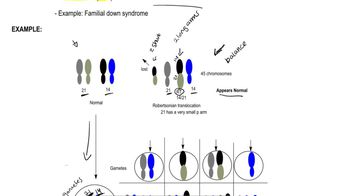For the following crosses, determine as accurately as possible the genotypes of each parent, the parent in whom nondisjunction occurs, and whether nondisjunction takes place in the first or second meiotic division. Both color blindness and hemophilia, a blood-clotting disorder, are X-linked recessive traits. In each case, assume the parents have normal karyotypes (see Table 10.2).
A color-blind man and a woman who is wild type have a daughter with Turner syndrome (XO) who has normal color vision and blood clotting.
Ch. 10 - Eukaryotic Chromosome Abnormalities and Molecular Organization
All textbooks Sanders 3rd Edition
Sanders 3rd Edition Ch. 10 - Eukaryotic Chromosome Abnormalities and Molecular Organization
Ch. 10 - Eukaryotic Chromosome Abnormalities and Molecular Organization Problem 32
Problem 32
 Sanders 3rd Edition
Sanders 3rd Edition Ch. 10 - Eukaryotic Chromosome Abnormalities and Molecular Organization
Ch. 10 - Eukaryotic Chromosome Abnormalities and Molecular Organization Problem 32
Problem 32Chapter 10, Problem 32
A healthy couple with a history of three previous spontaneous abortions has just had a child with cri-du-chat syndrome, a disorder caused by a terminal deletion of chromosome 5. Their physician orders karyotype analysis of both parents and of the child. The karyotype results for chromosomes 5 and 12 are shown here. Which parent has an abnormal karyotype? How can you tell? What is the nature of the abnormality?
 Verified step by step guidance
Verified step by step guidance1
Identify the genetic disorder: Cri-du-chat syndrome is caused by a deletion on chromosome 5.
Review the karyotype results: Compare the karyotypes of both parents and the child, focusing on chromosome 5.
Look for deletions: Check if either parent has a deletion on chromosome 5 similar to the child’s deletion.
Consider balanced translocations: If no deletion is found, examine if one parent has a balanced translocation involving chromosome 5 and another chromosome, such as chromosome 12.
Determine the abnormality: Conclude which parent has the abnormal karyotype based on the presence of a deletion or a balanced translocation that could lead to the child’s condition.

Verified Solution
Video duration:
1mWas this helpful?
Key Concepts
Here are the essential concepts you must grasp in order to answer the question correctly.
Karyotype Analysis
Karyotype analysis is a laboratory technique that involves the examination of an individual's chromosomes to identify genetic abnormalities. It provides a visual representation of the number and structure of chromosomes, allowing for the detection of deletions, duplications, or other structural changes. In this case, analyzing the karyotypes of the parents and child will help determine if there are any chromosomal abnormalities linked to the child's cri-du-chat syndrome.
Recommended video:
Guided course

Chi Square Analysis
Cri-du-chat Syndrome
Cri-du-chat syndrome is a genetic disorder caused by a deletion of a portion of chromosome 5, specifically at the 5p15.2 region. This condition is characterized by distinctive features, including a high-pitched cry resembling a cat, developmental delays, and various physical anomalies. Understanding this syndrome is crucial for interpreting the karyotype results and assessing the potential genetic contributions from the parents.
Recommended video:
Guided course

Robertsonian Translocations
Chromosomal Abnormalities
Chromosomal abnormalities can occur in various forms, including deletions, duplications, inversions, and translocations. In the context of this question, a terminal deletion of chromosome 5 is responsible for the child's cri-du-chat syndrome. Identifying which parent has an abnormal karyotype will involve comparing the karyotype results to determine if one parent carries a similar deletion or other chromosomal irregularities that could explain the child's condition.
Recommended video:
Guided course

Chromosome Structure
Related Practice
Textbook Question
274
views
Textbook Question
For the following crosses, determine as accurately as possible the genotypes of each parent, the parent in whom nondisjunction occurs, and whether nondisjunction takes place in the first or second meiotic division. Both color blindness and hemophilia, a blood-clotting disorder, are X-linked recessive traits. In each case, assume the parents have normal karyotypes (see Table 10.2).
A man who is color blind and has hemophilia and a woman who is wild type have a daughter with triple X syndrome (XXX) who has hemophilia and normal color vision.
282
views
Textbook Question
A healthy couple with a history of three previous spontaneous abortions has just had a child with cri-du-chat syndrome, a disorder caused by a terminal deletion of chromosome 5. Their physician orders karyotype analysis of both parents and of the child. The karyotype results for chromosomes 5 and 12 are shown here.
Are the chromosomes in the child consistent with those expected in a case of cri-du-chat syndrome? Explain your reasoning.
296
views
Textbook Question
A healthy couple with a history of three previous spontaneous abortions has just had a child with cri-du-chat syndrome, a disorder caused by a terminal deletion of chromosome 5. Their physician orders karyotype analysis of both parents and of the child. The karyotype results for chromosomes 5 and 12 are shown here.
Why does this parent have a normal phenotype?
220
views
Textbook Question
A healthy couple with a history of three previous spontaneous abortions has just had a child with cri-du-chat syndrome, a disorder caused by a terminal deletion of chromosome 5. Their physician orders karyotype analysis of both parents and of the child. The karyotype results for chromosomes 5 and 12 are shown here.
Diagram the pairing of the abnormal chromosomes.
209
views
Textbook Question
A healthy couple with a history of three previous spontaneous abortions has just had a child with cri-du-chat syndrome, a disorder caused by a terminal deletion of chromosome 5. Their physician orders karyotype analysis of both parents and of the child. The karyotype results for chromosomes 5 and 12 are shown here.
What segregation pattern occurred to produce the gamete involved in fertilization of the child with cri-du-chat syndrome?
204
views